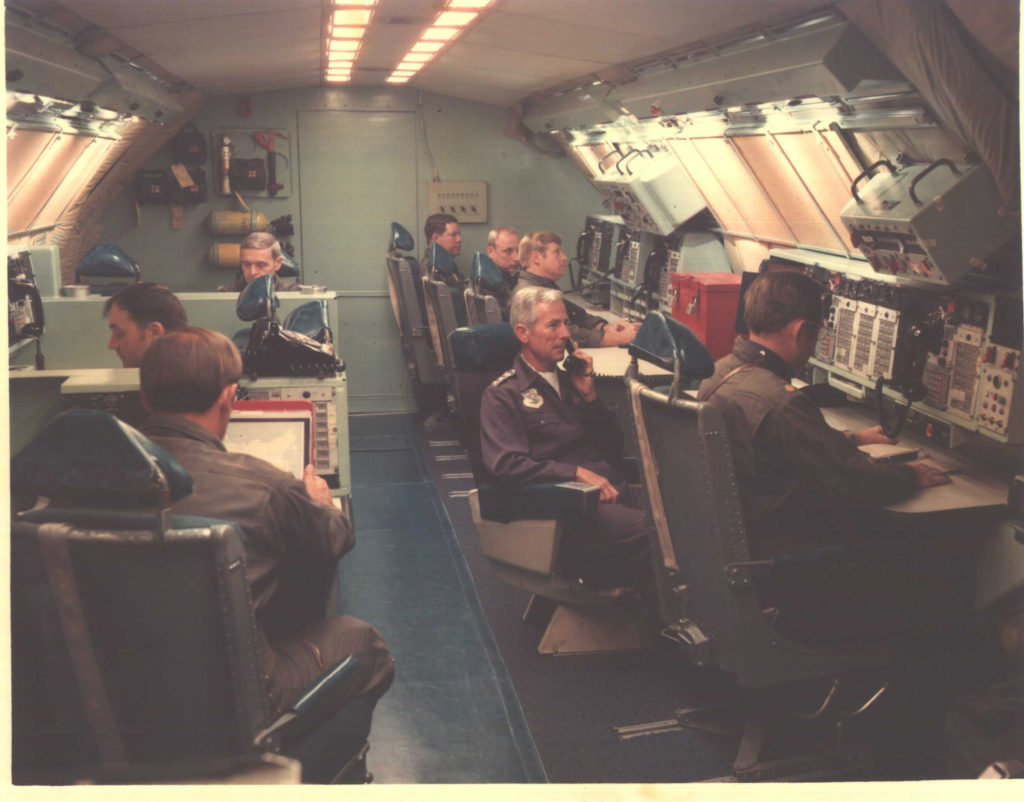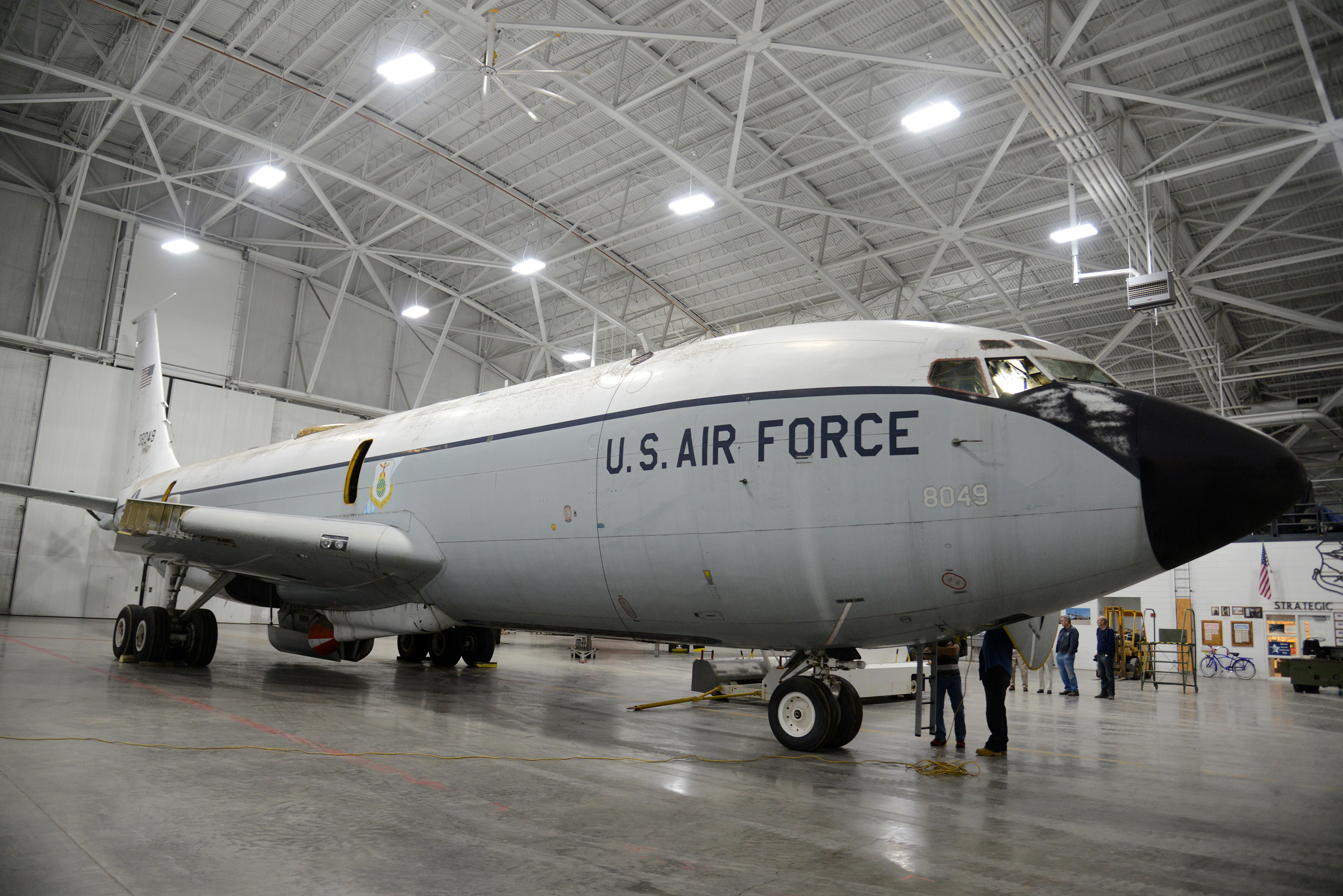Looking Glass Plane - It's important to remember: While the Mercury has demonstrated its usefulness as an air communications center to support troops in the field, an air command post is considered successful if it is not required to fulfill its primary mission.
In a military that works with Raptor stealth fighters, A-10 tank busters, B-52 bombers and Harrier jump jets, the US Navy's E-6 Mercury, based on the 707, may not look very aggressive. But don't be fooled by appearances. Although the Mercury lacks its own weapons, it may be the most lethal aircraft operated by the Pentagon, as its mission is to command the launch of land-based and sea-based nuclear ballistic missiles.
Looking Glass Plane

Of course, the US military has a strategic Global Operations Center in Nebraska and ground transmitters to communicate with the nuclear triad. However, the nefarious purpose of the E-6 is to maintain the communications link between the national command body (initiated by the president and the secretary of defense) and US nuclear forces, even if the ground command center is destroyed by the enemy. first strike. In other words, you can cut off the head of a US nuke, but the crew will keep coming at you thanks to these doomsday planes.
Meet The E 6 Mercury: The Us Military's Most Powerful Plane For A Reason
The primary mission of the E-6 is known as Tacamo. Prior to the development of the E-6, TACAMO missions were carried out by EC-130G and Q Hercules aircraft, which had very low frequency radios to communicate with land-based transmitters and later naval submarines. Interestingly, France also operated its own TACAMO aircraft until 2001, four modified Transall C-160Hs.
The E-3 Sentry uses a long line of popular Boeing 707 aircraft, particularly the 707-320B Advanced military variant. With thirty-one communications antennas, the E-6As were initially tasked only with communicating with Navy submarines. Refitted with a more fuel-efficient CFM-56 turbojet and using an enlarged fuel tank, the E-6A can be refueled for up to fifteen hours in the air or seventy-two hours in flight.
To use the very high frequency radio, the E-6 must fly in a continuous orbit at high altitude, with the VLF radio located between one and five miles long vertical distance following a wire antenna mounted on the fuselage and tail. attitude! VLF signals can be picked up thousands of miles away by Ohio-class nuclear-powered ballistic missile submarines hidden underwater. However, the limited bandwidth of VLF transmitters means that they can only transmit raw data of thirty-five alphanumeric characters per second, making them
Slower than an old 14k internet modem from the 1990s. Still, all it takes is sending an Emergency Action message, ordering ballistic missile submarines to launch one of a menu of various planned nuclear attacks, from a full-scale nuclear strike. The E-6 system is also hardened to survive the electromagnetic shock of an exploding nuclear weapon below.
Operation Looking Glass: This Unassuming Looking Boeing E 6b Was Actually Known As \
From 1997 to 2006, the Pentagon upgraded its entire E-6A fleet to dual-engine E-6Bs, expanding the Mercury's capabilities and allowing it to serve as an airborne nuclear command post. In this role, it serves as backup for four large E-4 post-command aircraft based on the 747 Jumbo jet. The E-6B has an ultra-high frequency radio in its airborne launch control system, which allows it to remotely launch land-based ballistic missiles from underground silos, a task assigned to another US Air Force aircraft, the EC-135 Looking Glass. 707 options. The E-6 crew was expanded from fourteen to twenty-two for command posts that typically included an admiral or general. Additional UHF radios will give the E-6B access to the surviving MILSTAR satellite communications network, while the cockpit will be upgraded with new avionics and instruments from the 737NG. The E-6B can be distinguished in the photo by the additional pods mounted on the wings.
Mercury's extensive communications equipment enables nuclear-free command, control, and communications (C3) operations. Because of this, E-6 aircraft have been deployed several times to Europe and the Middle East to serve as C3 flying hubs. For example, VQ-4 was deployed to Qatar for three years from 2006 to 2009, where it relayed information such as Iraqi bombing reports and medical evacuation requests to US forces out of touch with their headquarters in Iraq.
Two Navy aerial reconnaissance squadrons currently operate E-6: VQ-3 Ironworkers and VQ-4 Shadows, both in Naval Strategic Communications Wing 1. Their home is at Tinker Air Force Base in Oklahoma. . Regularly forwarded from Travis AFB, California and Naval Air Station Patuxent River, Maryland. At least one E-6 is kept in the air at all times. On underwater communications missions, E-6s often fly in circles over the ocean at the lowest possible speed—for up to ten hours at a time. Those conducting the nuclear command mission are usually on high alert near Offutt Air Force Base in Nebraska. The E-6 nuclear mission also kept its operations somewhat secretive for conspiracy theorists and foreign propaganda outlets.

The E-6 platform should remain in service until 2040 due to a service life extension program and ongoing changes to its systems and radios. Although the Mercury has proven useful as an airborne communications center to support troops in the field, an airborne command post is considered a success if it is not required to fulfill its primary mission. . The heart of a nuclear deterrent is ultimately to convince potential adversaries that a first strike is not enough to prevent a deadly conflict. E-6s are a critical component of making the threat credible.
Russian, Us Military Jets Nearly Collide
Sebastian Roblin earned a master's degree in conflict resolution from Georgetown University and served as a university lecturer with the Peace Corps in China. He has also worked in education, editing and refugee camps in France and the United States. He currently writes on security and military history.During the height of the Cold War, the Strategic Air Command ran Airborne Command (also known as Operation Glass), an underground nuclear command based at Offutt Air Force Base. One of the last Boeing EC-135 Looking Glass aircraft is being restored for permanent display at the Strategic Air and Space Museum in Ashland. Volunteers and former crew members of The Glass reflect the pride and commitment they bring to the Cold War icon, as they say.
Explore the history of this story William, Luther, and Cody Explore the history of this story Explore the statue on the hill Discover the culture, crafts, and cuisine of this story before St. Petersburg. Pat! Find this story Discover the culture, crafts and cuisine Find this story Explore the Nebraska All-Star Party.
Find this story The Story of Solomon Butcher Frontier Photographer Find this story The Story of The Girl at Broken Bow Find this story The History of Remembering Kloefkorn Find this story The History of the Tuskegee Heroes Find this story The Story of Bright Eyes Find this story The Killing of the Great Bison Find this story Betty's One Room school history Find this story This story Wonder of History on the Prairie All History Stories The Strategic Air Command (SAC) launched the Looking Glass mission on February 3, 1961, using the Boeing EC. -135C aircraft. Looking Glass or Operation Looking Glass is the code name used for the air command and control center controlled by the Air Force at the beginning of Looking Glass.
If the ground-based command center (Launch Minuteman Control Facility / Launch Control Center) is destroyed and they can no longer perform their duties in sending commands to the launcher for launch, Operation Looking Glass will be launched. and providing command and control over land-based nuclear forces.
Rook The Looking Glass Wars By Dragonrider13025 On Deviantart
The Boeing EC-135C Looking Glass was in the air 24 hours a day for more than 29 years, ending its continuous vigil on July 24, 1990 when the Air Force ceased aerial vigilance. After that date, the air command center will remain on ground or air alert 24 hours a day. This new strategy lasted until October 1, 1998. The Boeing EC-135C was in service for 37 years from February 1961 and completed its final mission on October 1, 1998.
In the early stages of the Looking Glass program, the Air Force used only the KC-135A and KC-135B aircraft from Boeing. The KC-135A was modified and redesignated as the EC-135A. In the KC-135B modification, they were redesignated as EC-135C, SAC deployed 8 of the EC-135C. Historically, there are 4 EC-135 models. Model A, C, G and L.
The EC-135C Airborne Command Post is nicknamed "The Looking Glass" because its mission "mirrors" the command, control and communications on the ground at the USSTRATCOM Global Operations Center (GOC) at Offutt Air Force Base, Nebraska. ".
While the EC-135 is actively flying, pilots and copilots are required to wear eye patches when they reach DEFCON 2 or higher. This patch is in the War Order Contingency Pack on the plane. It is based on probability
Index Of /hjg/aircraft2/boeing/ec 135
Sig p365 tulster holster, sig p365 iwb holster, sig holsters p365, sig p365 sas holster, sig p365 xl holster, sig p365 hybrid holster, appendix holster sig p365, safariland holster sig p365, sig p365 belt holster, sig p365 holster, sig p365 purse holster, sig sauer p365 holster

0 Comments